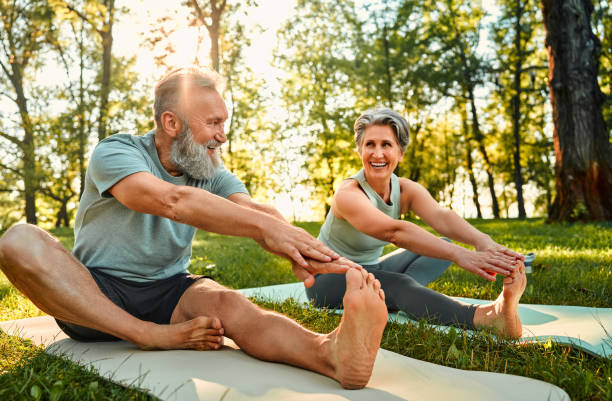As we age, maintaining mobility and independence becomes increasingly important. One key element to achieving this is proper flexibility training. For seniors, joint health is often a concern due to natural wear and tear, arthritis, or decreased activity levels. However, engaging in flexibility exercises can help maintain range of motion, reduce pain, and improve overall quality of life.
In this blog, we will explore the importance of flexibility training for senior joint health and how it can be incorporated into daily routines.
Contents
Understanding Joint Health and Aging
Aging is a natural process that affects our joints in many ways. Over time, the cartilage between joints can wear down, leading to stiffness, discomfort, or even osteoarthritis. The muscles surrounding the joints may also lose strength and flexibility, exacerbating joint problems. Seniors may notice a decreased range of motion, making everyday tasks like bending, reaching, or walking more difficult.
Maintaining joint health is crucial for seniors to preserve their independence and ability to perform daily activities. While it’s impossible to stop the aging process, regular flexibility training can slow down joint deterioration and alleviate symptoms of common joint-related conditions.
Benefits of Flexibility Training for Seniors
Flexibility training offers a wide range of benefits, particularly for those in their senior years. Here are some key reasons why it should be a part of every senior’s wellness routine:
1. Increased Range of Motion
Flexibility exercises stretch and elongate muscles, which in turn helps joints move through their full range of motion. This can prevent stiffness and keep seniors active, enabling them to perform daily tasks more easily. Regular flexibility training helps maintain or even improve the range of motion, counteracting the natural decrease that comes with aging.
2. Reduced Risk of Injury
As flexibility diminishes, the risk of injury increases, particularly in the joints. Due to joint instability and tight muscles, seniors are more prone to falls, sprains, and strains. By keeping muscles flexible and joints mobile, seniors can significantly reduce the likelihood of injury, making everyday movements safer and more controlled.
3. Decreased Joint Pain
Stiff and inflexible joints often result in pain, particularly in those who have arthritis or other joint conditions. Stretching exercises help loosen tight muscles and tissues surrounding the joints, alleviating pressure and discomfort. Flexibility training can reduce the inflammation and stiffness that contribute to joint pain, offering seniors a natural way to manage symptoms.
4. Improved Posture and Balance
Flexibility training isn’t just about keeping joints healthy—it also plays a vital role in maintaining good posture and balance. Poor posture puts extra strain on the joints, especially in the back, hips, and knees. Stretching the muscles and joints helps seniors maintain proper alignment and reduces the risk of developing postural problems that can worsen joint issues over time.
5. Better Circulation and Reduced Inflammation
Flexibility exercises can enhance blood flow to the muscles and joints, promoting healing and reducing inflammation. Increased circulation is especially beneficial for seniors who suffer from joint-related conditions, as it helps deliver essential nutrients to the affected areas, speeding up recovery and reducing pain.
Types of Flexibility Exercises for Seniors

Flexibility training for seniors doesn’t need to be complicated or strenuous. Gentle stretching routines can yield significant benefits without putting too much strain on the body. Here are some effective and senior-friendly flexibility exercises to consider:
1. Static Stretching
Static stretching involves holding a stretch for 15 to 30 seconds, targeting specific muscle groups. This form of stretching helps lengthen the muscles and improve joint flexibility. Common static stretches include hamstring, quadriceps, and shoulder stretches.
2. Dynamic Stretching
Unlike static stretching, dynamic stretching involves controlled movements that gently take the joints through their full range of motion. Examples include arm circles, leg swings, and neck rotations. These movements help warm up the muscles and improve joint flexibility before engaging in more strenuous activities.
3. Yoga and Pilates
Yoga and Pilates are excellent options for seniors looking to improve their flexibility and joint health. These low-impact practices focus on controlled movements and stretches, making them ideal for those with joint pain or stiffness. Additionally, yoga and Pilates enhance balance and core strength, further supporting joint stability.
4. Water-Based Exercises
Water-based exercises, such as aqua aerobics or swimming, are highly effective for seniors with joint pain or limited mobility. The buoyancy of the water reduces pressure on the joints while allowing for a full range of motion. This type of exercise is particularly beneficial for those with arthritis, as it helps improve flexibility without causing discomfort.
How to Get Started
Before starting any new exercise routine, seniors should consult with a healthcare provider or physical therapist to ensure they choose safe and appropriate exercises for their specific needs. It’s important to start slowly, gradually increasing the intensity and duration of flexibility training over time. Incorporating flexibility exercises into daily routines, such as stretching before getting out of bed or after a walk, can make it easier to stick with the practice.
For best results, seniors should aim to engage in flexibility training at least three to five times a week. Consistency is key to maintaining joint health and preventing further deterioration.
Conclusion
Flexibility training is an essential component of senior wellness, particularly for joint health. By incorporating simple stretching exercises into daily routines, seniors can maintain their range of motion, reduce pain, and improve their overall quality of life. In the long run, this type of exercise not only supports physical health but also enhances mental well-being, empowering seniors to lead active, fulfilling lives well into their golden years.
If you are in need of physical, occupational, or speech therapy services, please contact us at (920) 252-4442. We look forward to hearing from you.
